
Skelton Castle can refer to either a ruined medieval castle or an 18th-century Gothic style country house that replaced it. The site of both buildings is the village of Skelton, in North Yorkshire, England. The house is Grade I listed.

Skelton Castle can refer to either a ruined medieval castle or an 18th-century Gothic style country house that replaced it. The site of both buildings is the village of Skelton, in North Yorkshire, England. The house is Grade I listed.
The castle was built of stone by Robert de Brus in 1140. It had two look-out towers, dungeons, and a moat with a drawbridge and portcullis. [1]
In 1265 it was surrendered to King Henry III. In 1272 it went to Walter de Fauconberg and remained in the family for the next 200 years. In 1490 it was inherited by William Conyers, when it was described as ruinous. From him it passed into the Trotter family and then by marriage to the Hall family by the marriage of Joseph Hall to Catherine Trotter. Their son John inherited and changed his name to Hall-Stevenson after marrying Ann Stevenson. He formed the "Demoniacks" club who met at the ruins of the castle for drinking bouts. [2]
His son, Joseph Hall-Stevenson, died within a year of his father and thus Joseph's son John Hall-Stevenson (1766–1843) inherited the castle. In 1788 he changed his name to John Wharton and was Member of Parliament for Beverley between 1790 and 1820. [3] He also demolished the castle and replaced it by the current country house between 1770 and 1817. [4]
The present house is built of dressed sandstone with a roof of Lakeland slate. It is a two-storey block with a 5-bay frontage. It incorporates some remains of the medieval castle. The house was built c.1770 and extended in 1810-1817 by Ignatius Bonomi. [5]
It was constructed between 1788 and 1817 for John Wharton, Member of Parliament for Beverley who had inherited the ruined Skelton Castle from his father Joseph Hall-Stevenson in 1786. John Wharton had changed his name from Hall-Stevenson to Wharton to comply with the terms of a legacy. He inherited a considerable fortune from his aunt, much of which he spent of demolishing the castle and building his new home. He died childless and in poverty in 1843 and Skelton devolved to his nephew John Thomas Wharton of Gilling. The property then descended in the Wharton family to William Henry Anthony Wharton, High Sheriff of Yorkshire for 1925, and on his death in 1938, to his daughter Margaret Winsome Ringrose Wharton. She had married Christopher Hildyard Ringrose, a Royal Navy captain, who had added the additional surname of Wharton to that of Ringrose. She lived there until at least 1986, by which time her relative, Major Wharton, actually ran the estate on account of her age. [1]
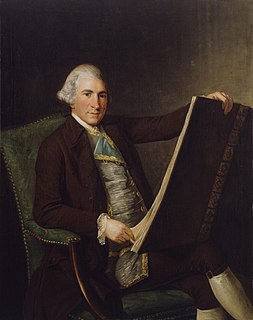
Robert Adam was a Scottish neoclassical architect, interior designer and furniture designer. He was the son of William Adam (1689–1748), Scotland's foremost architect of the time, and trained under him. With his older brother John, Robert took on the family business, which included lucrative work for the Board of Ordnance, after William's death.

Sir William Chambers was a Scottish-Swedish architect, based in London. Among his best-known works are Somerset House, London, and the pagoda at Kew. Chambers was a founder member of the Royal Academy.

Duke of Northumberland is a noble title that has been created three times in English and British history, twice in the Peerage of England and once in the Peerage of Great Britain. The current holder of this title is Ralph Percy, 12th Duke of Northumberland.

James Wyatt was an English architect, a rival of Robert Adam in the neoclassical and neo-Gothic styles. He was elected to the Royal Academy in 1785 and was its president from 1805 to 1806.
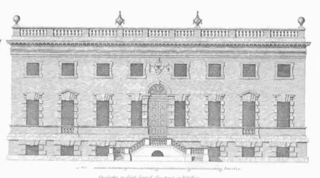
Colen Campbell was a pioneering Scottish architect and architectural writer, credited as a founder of the Georgian style. For most of his career, he resided in Italy and England.
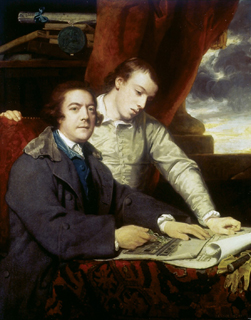
James Paine (1717–1789) was an English architect.
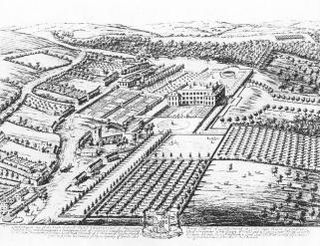
Londesborough Hall is a country house in the village of Londesborough in the East Riding of Yorkshire, England, close to the towns of Market Weighton and Pocklington.

John Carr (1723–1807) was a prolific English architect, best known for Buxton Crescent in Derbyshire and Harewood House in West Yorkshire. Much of his work was in the Palladian style. In his day he was considered to be the leading architect in the north of England.
Thomas Wharton, 2nd Baron Wharton, of Wharton and Nateby, Westmoreland, Beaulieu alias New Hall, Essex and Westminster, Middlesex, was an English peer.
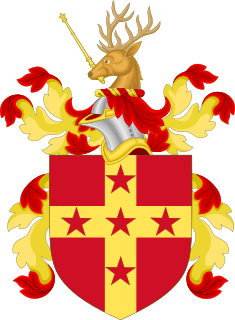
The Randolph family is a prominent Virginia political family, whose members contributed to the politics of Colonial Virginia and Virginia after it gained its statehood. They are descended from the Randolphs of Morton Morrell, Warwickshire, England. The first Randolph to come to America was Henry Randolph in 1643. His nephew, William Randolph, later came to Virginia as an orphan in 1669. He made his home at Turkey Island along the James River. Because of their numerous progeny, William Randolph and his wife, Mary Isham Randolph, have been referred to as "the Adam and Eve of Virginia." The Randolph family was the wealthiest and most powerful family in 18th-century Virginia.
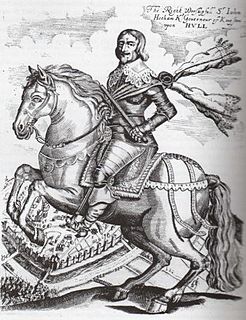
The Sheriff is the oldest secular office under the Crown. Formerly the Sheriff was the principal law enforcement officer in the county but over the centuries most of the responsibilities associated with the post have been transferred elsewhere or are now defunct, so that its functions are now largely ceremonial.

Pendragon Castle is a ruin located in Mallerstang Dale, Cumbria, south of Kirkby Stephen, and close to the hamlet of Outhgill, at grid reference NY781025. It stands above a bend in the River Eden, overlooked by Wild Boar Fell to the south-west and Mallerstang Edge to the east. It is a grade I listed building.
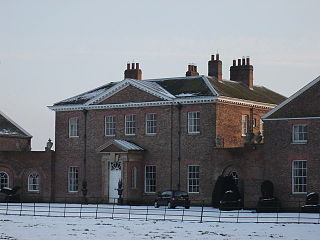
Houghton Hall, Sancton, near Market Weighton, is a Grade I listed Georgian country mansion in the East Riding of Yorkshire, England, set in an estate of 7,800 acres (32 km2). Located on the estate is the village of Sancton and the vestigial remains of the ancient hamlet of Houghton. It was built c. 1765–8 by Philip Langdale to the designs of Thomas Atkinson and underwent minor remodelling in 1960 by Francis Johnson. It is built in pink brick with stone dressing and slate roof, with a three-storey, 5-bay main block.

William Henry Lambton (1764–1797) was a British Member of Parliament (MP) who represented the City of Durham in the House of Commons.

Archibald Elliot was a Scottish architect based in Edinburgh. He had a very distinctive style, typified by square plans, concealed roofs, crenellated walls and square corner towers. All may be said to derive from the earlier local example of Melville Castle by James Playfair. Many of his works have been demolished.

Sir Jeffry Wyatville was an English architect and garden designer. Born Jeffry Wyatt into an established dynasty of architects, in 1824 he was allowed by King George IV to change his surname to Wyatville. He is mainly remembered for making alterations and extensions to Chatsworth House and Windsor Castle.
John Hall-Stevenson (1718–1785), in his youth known as John Hall, was an English country gentleman and writer.
John Wharton was a British landowner and MP.

Dangan Castle is a former stately home in County Meath, Ireland, which is now in a state of ruin. It is situated by Dangan Church on the Trim Road. The castle is the former seat of the Wesley (Wellesley) family and is located outside the village of Summerhill. It was the childhood home of Field Marshal Arthur Wellesley, 1st Duke of Wellington.

Howley Hall is a ruined Elizabethan country house in Batley, West Yorkshire, England. It has been designated a scheduled monument since 1997.